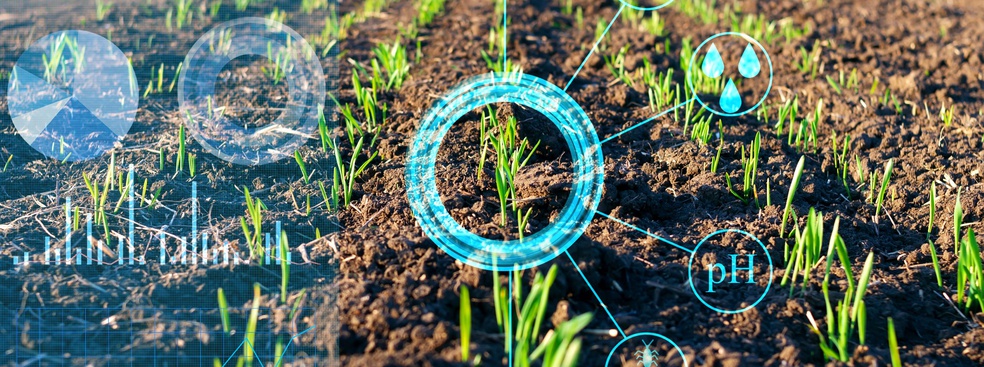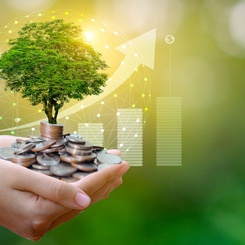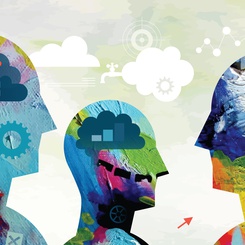With Frédéric Oble
The agri-food sector is currently facing several simultaneous transitions. We can look at these as though we were physicists, and see each transition like a phase change, like how liquid changes to gas. In agri-food, though, we don’t yet know what their duration will be, what paths they will take, what their consequences will be… or what the final phase will look like.
What do these transitions entail? In early 2021, we saw the dramatic consequences of alternating periods of warm weather and frost on orchards and vineyards. Climate change is the main transition weighing on agriculture and the food industry. While the industry does produce greenhouse gasses, agriculture can also reduce atmospheric CO2 by increasing soil carbon sequestration. In addition to the initiatives to fight climate change, agriculture also urgently needs to adapt to climate change as it risks jeopardizing access to affordable food for much of the population. For example, national wheat production in France was at 42 millions of tonnes in 2015 and lowered to 29 millions of tonnes in 2016, a decrease of around 30 %. [1]
The second transition is demographic. The countryside and agriculture jobs don’t attract young people - but around 50% of farmers will be retiring over the next 10 years. [2] Dietary and nutritional transitions are also in motion. The dietary transition is typically a slow-moving phenomenon: it has taken us from a hunter-gatherer diet to one heavy in beef, and shifted the balance between animal and vegetable proteins in favor of the former. While some countries made this transition over several centuries - in 17th-century France, King Henri IV designated poule au pot (chicken stew) a national dish - the transition was much faster in China and occurred over the course of a few short decades. The nutritional transition refers to eating differently to maintain one’s health; it is ongoing, as obesity remains prevalent in many countries. Other transitions are also underway: a social transition (for example, preferring local products), a technological transition (using digital technologies in the food industry) and an energy transition. An energy transition refers to the production of green energy. Livestock farmers are potential energy producers: by transforming manure into methane via methanation and then burning the methane, they produce electricity, heat, water, and carbon dioxide, the latter three of which can be used in greenhouses. In the south of France, wine producers are witnessing their vines dying of thirst. To avoid evapotranspiration, some are covering their vines with solar panels (e.g., www.ombrea.fr)
Agri-food companies face many challenges. In 2017, a study on potential consumer habits in France in 2025 identified 16 consumer trends, like a preference for local producers and vegetable proteins, but also authentic traditional products. [3] One could argue that with so many trends, there aren’t really trends as such. The consumer compass that companies usually rely on to direct their strategy is not working as well as it did before. These combined transitions create uncertainty for agri-food stakeholders, who are impacted in different ways depending on their position in the food chain, from farm to fork. Distributors, who can change their offerings most quickly, are usually the least impacted by sudden changes than farmers, who have less flexibility. A dairy products brand could imagine transitioning to vegan cheeses, but for a Sisteron-based lamb producer who is AOP-certified, (controlled designationof origin, a French certification offered to certain products) transitioning poses more of a difficulty.
In such a situation, what stance do companies take? The first stance is one of denial and hope, based on a belief that existing problems are only temporary and will disappear from one day to the next. Those with this stance use history to back it up: “We have already been impacted by drought. It’s nothing new, and we’ve survived it before”. In other words, we just have to wait patiently for the calm after the storm. We have the impression that this stance is increasingly uncommon.
Others go a step further and are getting ready for the next storm by increasing their resilience. They believe that it is not possible to continue business as usual. It’s true, but what should we do? Here, too, we’ve observed different strategies. The first consists of developing a transformation plan, founded on strong convictions and with ambitious environmental and social objectives. Such is the case for three of the partners of the Food Business Challenges Chair, namely Bel, Lesaffre, and METRO. Where there’s a will, there’s a way!
The second strategy consists of not putting all one’s eggs in the same basket: in other words, intelligently diversifying one’s activities. By intelligently, we mean something like growing a variety of plants that react differently to environmental hazards. This is the strategy that the geographer Gould observed in 1960s Ghana. A region in Ghana experienced enormous variability in precipitation in the 1960s; traditionally, the region’s main crops were yams, millet, maize, cassava, and certain types of rice. Unfortunately, all of these crops are sensitive to climatic conditions. For example, yam production varies by a multiple of 8 between dry years and those with optimal precipitation. In response, local farmers decided to vary their crops by also planting species that like rain, species that thrive in drought, and species that react poorly under extreme conditions but do well in intermediate conditions.[4]
The third approach uses an intensive experimental phase. Jean-François Loiseau, President of the cereal cooperative Axéréal and partner of the Chair, shares the same ambition as our other three partners. However, for a large agricultural cooperative with members spread out over different regions, the first step is finding solutions. There is no single best solution: the key is to prepare for a “diversified future”. “To get there, we will need to create, compare, make mistakes and, above all, discover… sometimes giving up old habits”. [5] A process that our colleagues at the ESSEC Center for Entrepreneurship and Innovation would likely class as entrepreneurial! For our part, we compare this statement to the approach of Amazon’s Jeff Bezos, a pro in experimentation, and who essentially says: “Today, we need to take chances. Some will pay off, others won’t. But in all cases, we will still win, because we will learn from our failures”.
All these challenges fueled the creation of the Food Business Challenges chair, and continue to fuel our drive to support companies in the many transformations facing the food industry!
References
[1] Source FAOSTAT - Compilation par les auteurs.
[2] Source AFP - Conférence de presse de la Mutualité Sociale Agricole du 19 juin 2019
[3] Étude prospective sur les comportements alimentaires de demain (Blezat Consulting, Crédoc, Deloitte Développement Durable), disponible sur le site agriculture.gouv.fr
[4] Lire: Olivier Fourcadet, La coopération affecte-t-elle la résistance des entreprises membres aux chocs exogènes? Colloque International sur la diversité et la durabilité des modèles coopératifs dans un contexte de crises de la mondialisation, Paris, 6-7 novembre 2012 - Disponible auprès de l’auteur.
[5] Jean-François Loiseau, L’agriculture ou l’avenir combinatoire, publié le 15 décembre 2020 sur Linkedin Pulse






